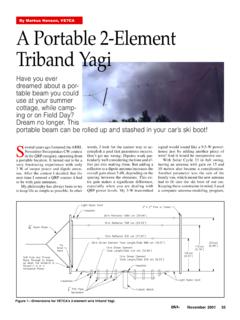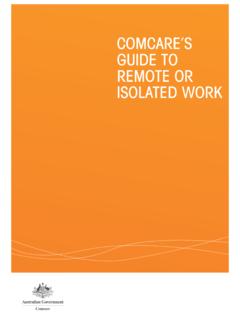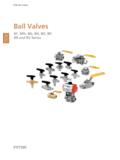Transcription of Health and Safety Executive Operational Circular OC …
1 - 1 - Health and Safety Executive Operational Circular OC 282/28 Review Date 30/04/2022 Open Government Status Fully Open Version No & Date 6: 30/04/2012 Author Unit/Section FOD Central Specialist Division To All HSE Inspectors FIT TESTING OF RESPIRATORY PROTECTIVE EQUIPMENT FACEPIECES This updated Operational Circular (pages 1-6) gives practical advice on the inspection of the suitability of RPE fit testing methods and the meaning of the results generated. The accompanying information document (page 7 onwards) gives further more detailed information on fit testing. INTRODUCTION 1 Where respiratory protective equipment (RPE) is used as a control measure under Health and Safety Legislation (see paragraph 6), it is vital that the selected RPE is adequate and suitable. RPE must reduce exposure to as low as reasonably practicable, and in any case to an acceptable level ( below any applicable Workplace Exposure Limits or Control Limits).
2 To ensure that the selected RPE has the potential to provide adequate protection for individual wearers, the ACoPs supporting COSHH, CAR and CLAW stipulate that tight-fitting RPE must be fit tested as part of the selection process. This will help to ensure that inadequately fitting facepieces are not selected for use. Ill-fitting facepieces can create inward leakages of airborne contaminants. Note: A tight-fitting facepiece is a full face mask, a half mask, or a filtering facepiece (commonly referred to as a disposable mask). The performance of these types of facepieces, irrespective of whether they are used in negative pressure respirators, power assisted respirators or compressed air supplied breathing apparatus, relies heavily on the quality of fit of the facepiece to the wearer s face.
3 An inadequate fit will significantly reduce the protection provided to the wearer. The presence of facial hair in the region of the faceseal will significantly reduce the protection provided. 1 2 General advice on selection is covered in HSE guidance HSG53. 2 This OC provides supplementary information for inspectors. 3 For RPE to be suitable it must be matched to the job, the environment, the anticipated airborne contaminant exposure level, and the wearer. As people come in all sorts of shapes and sizes it is unlikely that one particular type, or size of RPE facepiece, will fit everyone. Fit testing will help ensure that the equipment selected is suitable for the wearer. - 2 - 4 RPE fit testing should be conducted by a competent person. Competence can be demonstrated through achieving accreditation under the Fit2 Fit RPE Fit Test Providers Accreditation Scheme.
4 This Scheme has been developed by the British Safety Industry Federation (BSIF) together with industry stakeholders and is supported by HSE. The scheme is not compulsory and employers are free to take other action to comply with the law. One way employers can demonstrate good practice is by ensuring that the fit tester is appropriately accredited, for the type of service they offer, by the Fit2 Fit scheme. Further details on the scheme can be found at the web site: LEGAL REQUIREMENTS 5 The Approved Codes of Practice (ACoPs) supporting the Control of Substances Hazardous to Health Regulations 2002 (COSHH)3, the Control of Lead at Work Regulations 2002 (CLAW)4, the Control of Asbestos Regulations 2006 (CAR)5 and the Ionising Radiation Regulations 1999 require that all reasonable steps be taken to prevent exposure to substances hazardous to Health , or where prevention is not possible, to reduce exposure to the lowest level reasonably practicable.
5 6 If, despite the use of suitable control measures ( other than RPE) adequate control of exposure cannot be achieved, employers must provide suitable RPE (COSHH Regulations (3)(c), CLAW Regulations (3)(c), CAR Regulations (4)). The RPE provided must reduce the exposure to a concentration that is as low as reasonably practicable, and in any case below any applicable exposure or control limits. 7 The ACoPS 3, 4, 5, supporting the COSHH, CLAW and CAR Regulations recommend that the initial selection of tight-fitting facepieces should include a fit test. This is to ensure that the selected RPE has the potential to provide adequate protection for the wearer (L5 paragraph 150, L143 paragraph 196 and L132 paragraph 133).
6 The circumstances where repeat fit testing is needed are referred to in L5 paragraph 151, L143 paragraph 197 and L132 paragraph 134. 8 The employer must have documented evidence of the characteristics of the RPE to be used (CAR (4)(d)). Similar requirements are described in COSHH (4)(b), and CLAW (4)(b). These requirements are there to ensure that the RPE provided is suitable. The evidence to support the suitability will include fit test reports for facepieces with tight-fitting face seals. 9 Fit test reports should be available for all employees who wear RPE incorporating tight-fitting facepieces. Fit test records should be retained by the employer. These records must be kept available for inspection on request. - 3 - INSPECTION BY HSE 10 Inspectors should first ensure that suitable control measures including engineering controls are in use to minimise exposure to hazardous substances.
7 In relation to the use of RPE Inspectors should ensure that: 1) a management system exists for correct selection, use, storage and maintenance; 2) for tight-fitting facepieces the selection process has included an appropriate fit test. Where necessary, the results of the fit test report should be examined by the inspector for details, which should include the following: a) name of the person fit tested; b) make, model, and size of the facepiece; c) whether the wearer s own mask, company pool mask or a fit test service provider s test mask was used; d) the test exercises performed during the test; e) fit test method employed; Qualitative for filtering facepieces (FFPs, disposable masks) and half masks Quantitative for FFPs (disposable masks), half and full face masks f) Measured fit factor values for each exercise (if applicable); g) pass level used; h) date of the test; i) the details of the person carrying out the fit test.
8 3) the fit test certificate is valid and does relate to the correct RPE and the wearer. Checks should be carried out to establish the authenticity of the fit test certificate. This can be achieved by: a) comparing the facepiece in use to the details recorded on the fit test certificate; b) cross-checking the details on the fit test certificate with those retained by the fit test provider; - 4 - 4) the RPE in use is the same make, type and size as the face mask that was worn for the fit test; 5) the RPE issued to users is clean and well maintained (refer to L5 paragraphs 178-186, L143 paragraphs 215 - 225 and L132 paragraphs 191 197). 11 Selection of equipment and risk assessments must be based on the assigned protection factors (APFs), and not on fit factor results.
9 HSE Guidance HSG53, HSG247 (chapter 5), 6 and BS EN529, 7 provide details on APFs and RPE selection, use and maintenance. ACTION BY INSPECTORS 12 The enforcement issues referred to below are concerned with the fit testing of tight-fitting facepieces, and whilst each case should be judged on its own merits, inspectors are advised to consider formal enforcement actions where the RPE is considered to be unsuitable which include the following situations: (obviously the suitability must be weighed against the risks involved): 1) where persons are wearing tight-fitting facepieces and have not undergone and passed an appropriate fit test (see paragraph 14); 2) where fit test results are not readily available; 3) where the results show that a particular mask did not fit the wearer and the wearer is continuing to use that type and size of facemask.
10 Steps should have been taken to select a more appropriate facepiece and/or carry out retraining. Support from SGs/CSD3/HSL should be sought where appropriate. The suitability, use and maintenance aspects of personal protective equipment (PPE)/RPE should also be considered. POINTS TO NOTE 13 It is not necessary for employers to issue RPE to the wearers on a personal basis following fit testing. However, employers need to ensure that the make, model, type and size of facepiece that their employees wore, when successfully fit tested, is made available for use. 14 If an employee wears more than one type of tight-fitting facepiece then each type of facepiece should be subjected to fit testing. INTERPRETATION OF THE FIT TEST RESULTS 15 When quantitative fit testing devices, the Portacount, are used, these generate fit factor numbers.












